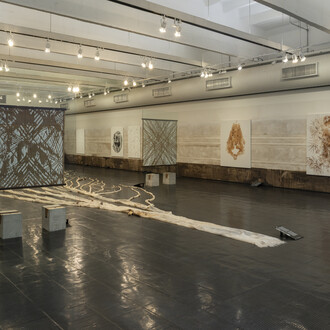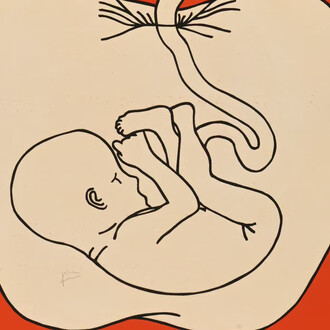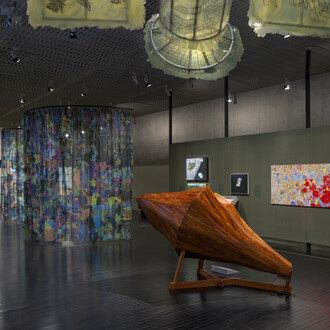The grid only exists when created, it is an organizational structure composed of horizontal and vertical lines that draw a system of spatial division, and thus, it is not found organically in the natural environment. André Azevedo combines a desire to challenge this system with an investigation into botanical imagery, operating in a field that twists traditional writing and visual codes. In the exhibition Mirage-writing, we encounter a singular universe, presented for the first time in such depth, navigating chromatic nuances in which blue, red, green, and black enter the fabric and transform into figuration. We inhabit the domain of codes that overlay our experience of the world and distance us from direct reality, and it is within this coded world that Mirage-writing operates. André Azevedo is an organizer of signs, a semiologist in action; his poetics explore the plastic possibilities of typewriting, a balance between the rigidity of the machine and the lyrical nature of floral figurative representation.
The work Datilográfica 9 engenders abstraction and opens the door to new universes. Standing before this piece is akin to tuning into radio stations decades ago. A piece of furniture/communication medium, the radio allows us to feel the sound waves of stations transmitting electromagnetic signals at specific frequencies, which we tune into until we find a frequency within the circuit. Datilográfica 9 is the tuning point of the exhibition, it invites us to enter this frequency and engage with a poetic apprehension of the coded world.
Azevedo tunes into the minimal particle, the letter, starting from the word "image" (imagem in portuguese) and proceeds to deconstruct, recompose, remake, and rebuild it, transforming it into an image, per se. The works, created on cotton fabric, are unframed; their stretched edges on wooden chassis are integral to the process of typewriting. In some pieces, subtle clues reveal that the image is forged from characters. The unveiling of layers becomes evident through the use of carbon paper, where each letter that pierced the surface becomes light, transformed into a visual score.
Regarding the choice of projected images, the illustrations revisit the life and natural elements of the earth and were appropriated from the book Historia natural: Vida de los animales, de las plantas y de la tierra – botánica, drawn from illustrated encyclopedic collections popular in the 19th and 20th centuries, in a pre-digital era. The work mimics the grammar of the machine and, at the same time, poetically corrupts it, opening cracks in the system of signification. Flowers, branches, and foliage materialize through the Is, Ms, As, Gs and Es, —in a rhythmic dialogue between machinic rigidity and ephemeral organicity.
Azevedo’s relationship with painting has grown closer. He approaches textile with a pictorial mindset, expanding the possibilities of image translation through a return to the analog. In works that replicate figures, at first glance they appear identical, but upon closer observation, subtle discrepancies in color and drawing emerge, rendering each repetition absolutely unique in its formation.
He uses a software that pixelates the image and translates it into code in order to construct an image. While this technology already exists within the field of textile printing, Azevedo redefines it through image translation—infusing individuality into each piece by introducing carbon and gesture, subverting technical reproducibility through the unpredictable. Writing slips out of control, and aura insists on appearing. Azevedo appropriates the mechanical nature of the device, letting the machine carry out the writing, instructing the channels to distribute ink as graphic signals, covering the surface, only to later obscure it again in a way that reveals something imagetic, producing a contrast between the color of the ink and that of the surface.
Writing is the science of the enjoyments of language, the possibility of a dialectic of desire, of an unpredictability of pleasure. For Roland Barthes, the written text always offers proof of desire: it is writing itself. What Azevedo proposes is to overflow writing; his practice conceives through writing a space of poetic enjoyment and new forms of imagetic perception.
The pictorial approach is both material and mental. The artist draws on thinkers such as Vilém Flusser, for whom culture is the attempt to deceive nature through technology, through machination. The numerical rules invented by humans, in the abstract, are capable of describing, explaining, and even predicting sensory experience. So powerful are the codes we construct that we build from them alternative versions of so-called reality, parallel worlds, multiple experiences of the here and now. In this understanding, every artifact is produced through the act of giving form to matter according to an intention. Manufacture corresponds to the strict sense of the term in + formation: to give form to something - in Azevedo's poetics, to translate letter into image.
The device becomes not merely a mechanical apparatus, but a complex entity, a compass between technology, culture, and humanity. Technological intervention and interaction organize and transform both reality and art, shaping new ways of living and experiencing. Through typing, Azevedo organizes graphic signs and draws with them, bringing action and thought into complete cohesion.
The typewriter functions as a mediator between nature and culture, adding another layer of complexity to the relationship between the artist and the viewer. This device also influences communication, generating new forms of expression and interpretation. In this sense, technology is not merely a means of transmitting information, it is also a system that shapes meaning and message. Azevedo’s poetic practice, beyond guiding thought, acts directly in the encounter with the other. It is only when a written work meets the other that it fulfills its intention, a kind of creative act.
By exploring various plastic possibilities of typewriting on textile surfaces, André Azevedo generates images from typography, where each character leaves its mark on the fabric, with stains of varying intensity. Within this logic of operation, he discovers a possible destiny for writing in the process of transforming typography into texture and writing into image. He reconfigures typewriting into a visual form, giving material body to what is elusive.
Mirage-writing is an attempt to capture what dissolves—a movement of approaching and withdrawing in order to decipher the drawing that passes through carbon and pigments the canvas, constructing a symbolic surface. In this way, the artist recovers a possible destiny for writing—hybrid, technical, and sensitive—where code provokes and projects a future for writing grounded in visuality. This future is unruly and, above all, dynamic. André Azevedo decodes a future from the past.
(Text by Mariane Beline and Luana Rosiello)













